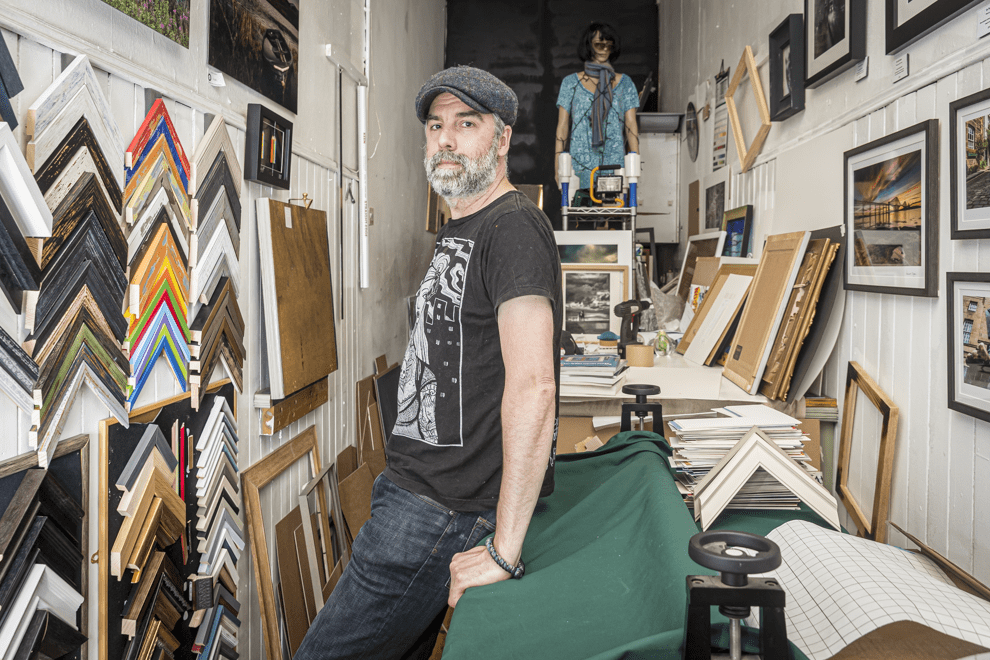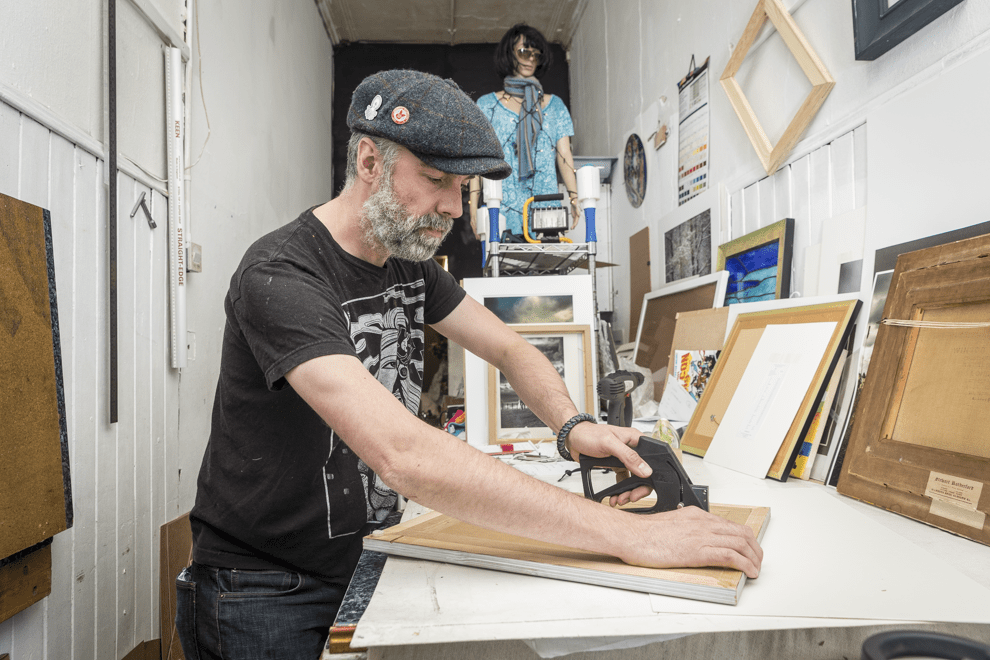June 26, 2019
Framing Photographs
Owner of Dundas Street Framers, Mark Bowman, chats about photography and the importance of photographs in a frame

In the age of social media, it’s easy for a photographer to get their work seen on Facebook, Instagram, and Twitter. However, there is quite a buzz when you print a photograph, put it in a frame and hang it on your wall. I offer my framed photographs for sale over on my Rich Dyson Photography website. Whilst I could use a basic frame, I think the frame around the image complements and adds to the product so I use an Edinburgh framer, Mark Bowman who is the owner of Dundas Street Framers. Mark is also a talented photographer, so I thought it would be good to have a chat with him about framing photographs and a bit more.
Rich Dyson: Hi Mark, could you just tell me a little about yourself?
Mark Bowman: My name is Mark Bowman, I’ve been a picture frame for a number of years. I’ve had the shop in Dundas Street for just over two years now. I was from a catering background but I trained years ago in Framing and I decided to make it my full-time occupation. Initially, just to start off framing my own photographs but now it’s turned into something else. I rarely get time to do my own stuff.
Rich Dyson: In the shop, you’ve got quite a lot of photography on the walls which readers can see from the picture at the top of the blog. Is photography one of the popular things with the customers and is it something people want to buy?
Mark Bowman: Yeah, we got quite a lot of photography and photographers in the door. It’s quite a mix, you get a lot of artists as well. There is a lot of photography that comes through the door for sure. I get the classical prints of photography and people’s own work, even you know, holiday snapshots and stuff. So there’s a lot going on.

Photographing Animals
Rich Dyson: Some of the photography on the wall is your own and I can see there is quite a feature of animals there. What is it that leads you to want to photograph farm animals?
Mark Bowman: Well, I was living on a small holding which had sheep and I used to own sheep as well. I spent a lot of time around farm animals, horses that type of thing. It’s often easier if the weather is a bit inclement and if it’s on your doorstep then it’s quite nice just quite easy to go out and take some shots of the animals instead of getting soaked and travelling doing some landscape photography, which is where I came from the landscape side of things. I’ve got quite an affinity with the animals really they don’t seem to be spooked by me too much so it works.
Rich Dyson: I was going to say that it’s always said that you don’t work with animals and children so how do you get in so close?
Mark Bowman: A lot of patience really to get to know them. I always find, especially with small animals like goats you get down to their level. They’re not so scared of you. If you’re towering above them and wandering around they tend to run away. If you sit on the ground most animals are pretty inquisitive, they’re going to come towards you at some point, even just have a look and if they see you’re not a threat, they become quite happy with you being around them. So that way, you can get more relaxed shots of them and just some different angles because you’re closer to the ground, you know?
Rich Dyson: Yeah, that’s one of the key things I see in your pictures is that you get a real connection with them just by changing your angle.
Mark Bowman: Yeah, that’s it. Exactly that, you know, I mean anyone you can take a picture of an animal from standing up anyone can do that. And it’s quite a standard thing. But I just I want to do something a bit different and show off a different side of the animal.

Landscape Photography
Rich Dyson: You talked about how you started off by doing landscape photography. Where are the places in and around Edinburgh that kind of really appeal to you in terms of the landscapes?
Mark Bowman: The bridges, I am down there quite a lot. I’ve been visiting the bridges for years taking photographs down there and I always find it quite a peaceful place. I’ve still yet to get a decent shot of the new bridge. I need to get down there and try and get one of those. The rail bridge is such an iconic Scottish landscape feature. It’s been shot to death with so many pictures of it, but you can still if the conditions are right you can still get a decent snap. You can find something a bit different you can do some more close-up shots of the water of the rock pools around there and you know just find something a bit different. Apart from the Pentlands is good for a wander. There are plenty of farm animals around there although they don’t know me as much so they don’t come as close.
Rich Dyson: It’s interesting that you just talked about the bridges is that it’s peaceful being there. Is that part of what helps your photography?
Mark Bowman: Yeah, I was always find that if you get out somewhere and you’ll know this yourself, but you don’t start taking photographs straight away. You can, but I always find I like to sit there for a while and just become accustomed to my surroundings and where I am and then you start seeing things a bit differently you hear things. And it just you know, if I just turned up somewhere right? It’s like a tourist, take a picture of something, brilliant, and back on the bus. You get the same shot as everyone else, if you’re lucky, it might not even be that good. But if you sit there and just become accustomed to a place and get a feel of the actual place, photography is not just about a picture, it’s about an emotional attachment as well. You have to connect with the environment and that does show on all the good landscape photographers, which I don’t include myself in, but all the good landscape photographers have a big connection with the areas that they take photographs from.
Rich Dyson: This is one of the things I always talk about during my landscape workshops. I tell people at times just to put the camera down and appreciate where they are.
Mark Bowman: Yeah exactly. you see a lot more with your eyes not looking around through a viewfinder.
Framing Photographs
Rich Dyson: I’m guessing photography because it’s fairly flat and it tends to be fairly standard sizes, that it’s probably one of the easier things that you have to frame in the shop.
Mark Bowman: It is actually, it really is. It’s a pretty staple. There’s a lot of things we can do with it such as box frames or whatever people want. It’s a pretty easy medium to frame.
Rich Dyson: What’s been one of the harder things to frame. What’s been some of the more interesting things to frame?
Mark Bowman: I’ve done a wedding garter which is interesting. Dog collars, you know pets that have passed. Not a very happy subject! Spirit measure from a pub, again someone died, I see a thing going on here!. He said it was his favourite pub and they decided they wanted his particular Spirit measure that he always had for his own drink framed. That was another interesting one. You get some interesting things through the door which makes the job more fun.
Rich Dyson: I think I saw on your Facebook feed that you framed a boxing glove?
Mark Bowman: Yeah, I’ve done some boxing gloves.
Rich Dyson: I guess that’s a bit hard to hang on the wall?
Mark Bowman: It’s not the sort of thing I would have on my wall but it means something to someone and that’s the whole thing with framing it.
Rich Dyson: Let’s just talk about the personal thing about framing. A lot of people now are taking pictures and they post on to Instagram or Facebook and people are seeing pictures electronically. Obviously, because it’s your job to frame printed photographs that have been taken, why is it you think that’s as important as the digital, if not more important?
Mark Bowman: Digital pictures don’t cover your wails. I think it’s just a nice thing. It’s a way of having your memories visible rather than searching on a computer. It’s a way of having your memories around you at all times, you know in your home. If you’ve got to turn a computer on every time and look up an image, no matter how good your filing system is, and you still see it brightly lit on a computer screen. They look totally different when they are printed especially on decent paper. A decent frame will set It off nicely. The frame is there, not to detract from picture, but to add to it and to show it off as it’s supposed to be. It’s quite a clinical thing to look at pictures on computers. I think it’s far more human to have a physical copy of your memory or your image on a wall.
Rich Dyson: You talked about the importance of printing good quality paper. Do you print your own shots, or do you get them printed?
Mark Bowman: I don’t print, I use A&M Imaging but I always try and get a decent paper My signature paper is a matt paper. I like matt, I like a matt print. It doesn’t work always if you’ve got water shots, that often works better with the gloss. I always like the finish from matt paper. I use studio smooth or photo rag 100% cotton paper and it soaks up the ink better, you get decent contrast. A lot of my shots are black and white and I like a lot of contrast.
Rich Dyson: If photographers have got prints that they are looking to get framed how can they come and find you?
Mark Bowman: It’s easy enough, you can pop in my shop at 132 Dundas Street, Edinburgh or you can look at the website www.dundasstreetframers.com You can also find me on Facebook and Instagram.
You can buy limited edition framed prints by Rich Dyson and framed by Mark Bowman at the Rich Dyson Photography website. Please sign up for the Edinburgh Photography Workshop monthly newsletter where you’ll get regular updates on interesting things happening in photography and some great tips. Sign up by clicking here.